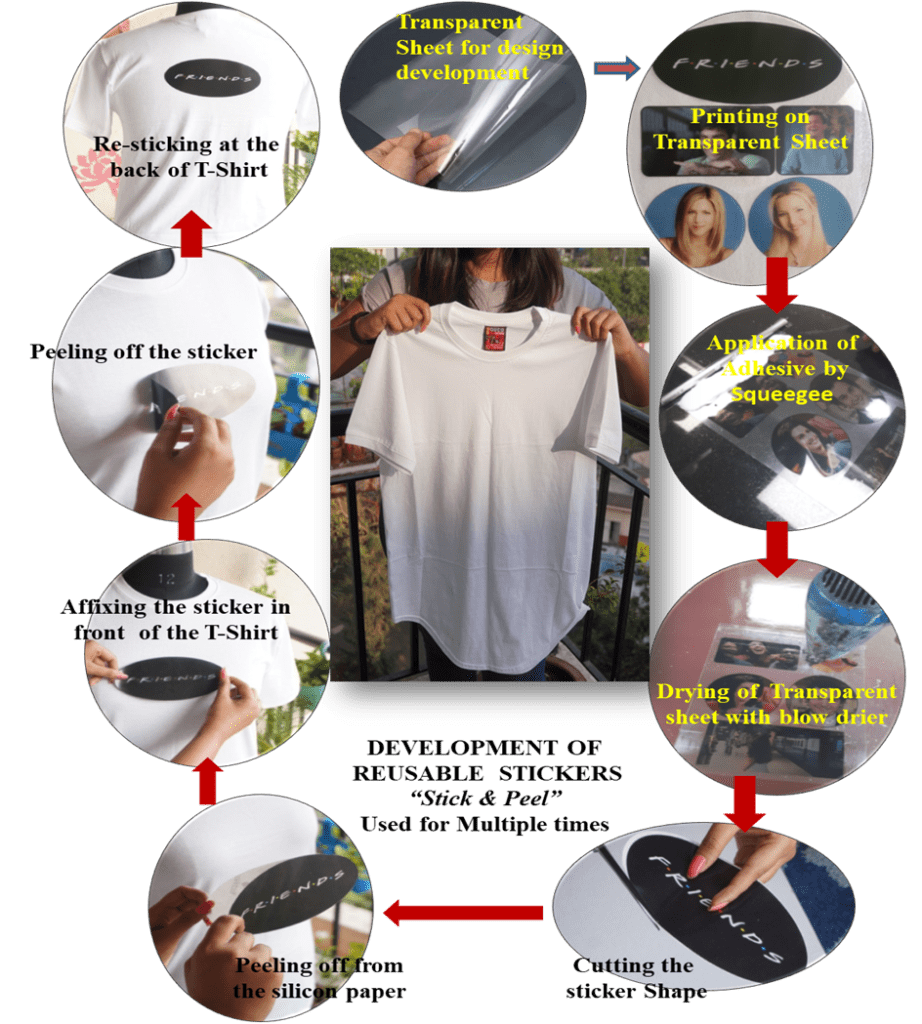by Ragini Gupta, M.Sc. & Dr. Sabita Baruah, Post Graduate Department of Textile Science & Apparel Design, SNDT Women’s University, Mumbai
ABSTRACT
T-shirts and the psychology of mainstream consumers have a strong connection. This connection often works in supernatural ways. Bold messages printed on T-Shirts help express one’s unusual outlook on everyday living. The graphics on T-shirts help draw attention one’s personal quirks and idiosyncrasies within an informal communication space. Sometimes, messages displayed on a T-shirt might bring psychological comfort to a person struggling to stand out from the crowd and establish a unique self identity. It is therefore, a very effective way of providing a temporary boost to one’s self esteem in a world were conformism stifles everyday life. Today, Graphic and Art T-shirts are in demand in many youth rebellion circles. They are readily available to social protestors in every part of the world. The study concluded that there is a potential market in the future for these reusable stickers. These Graphic and art T-shirts are sometimes customized to specific youth consumers and special occasions. Furthermore, it is possible to make different customized reusable stickers for T-shirt based on consumer’s choice or the intensity of their expression. Therefore, an experimental study was carried out to design and develop reusable stickers that can be used multiple times with “Stick & Peel” method. Also, these stickers can be placed on any part of the T-shirt such as front, back, sleeve and sides etc. For general market acceptance therefore, a survey was conducted. Further, it is environment friendly to make a reusable sticker than purchasing a new T-shirts every time you feel like buying.
Keywords: T-shirt, Psychology, Social expression, Graphic, and Art T-shirt
INTRODUCTION
The T-shirts are an iconic staple in American youth rebellion movements, fashion, and popular culture. Originally designed as an undergarment, the T-shirt has transformed itself into the most universal item in youth apparel. T- shirts are simple garments that have transformed the fashion world, created their own industry in garment decorating, and changed the way cultural messages are shared forever. The T-shirt, as we know it today, is an apparel staple. In fact, as the T-shirt is the basic attire in the wardrobe, it can be found in multiple colors, shapes and designs. It is a universal garment which can be worn in summers, winters, and the rainy season. T-shirts have transformed from a means of simple clothing to articles of complex political self-expression. It is for this reason that T-shirts have become very important cultural assets. Apart from being the most comfortable of clothing forms, messages on T-shirt soften help serve as a safety valve. They can help the youth communicate their pent up feelings through cleverly crafted messages.. The influence of T-shirt graphics on human psychology
Reflection of your individuality
T-shirts provide a personal canvas for individuals to announce their inner feelings to the world at large. They can also carry forward messages for making known publicly one’s hobbies, passions, interests, and social maladjustments. Sometimes, these messages can help reveal one’s inner self. Such identifications help T-shirt wearers bond with like-minded folks. Some messages can also help enlighten mainstream society. The artwork and messages on a T-shirt is often the best way to convey to the world what the wearer socially stands for.
Encouragement and support for social changes
Owing to some recent events, there is a surge in people wearing tees with slogans like, ‘Black Lives Matter.’ Such messages tell the world that the wearer supports a cause. A silent support strengthens the number of people who might also desire social change. By now, the world knows that it was an ingenious strategy of non-violent protests that brought about India’s independence. It is this type of silent support that often brings about social changes that human civilizations might desire. It was also reported that the behavioral intentions and perceptions of individuals can instantly change, based on the graphic featured on a T-shirt.
Most comfortable form of clothing
Wearing and carrying a T-shirt is as simple as throwing it on. A T-shirt is the second best thing that consumers would prefer to get cozy and cuddle with, if not the first. It is the comfort, warmth, and soft hug of a T-shirt that can help wearers sleep better. Comfort sometimes varies with T-shirt sizes and occasions. If it is comfort that wearers are looking for, a loosely fitting T-shirt may be the answer. Along with other fashion wears, T-shirts have been revolutionized over a period of time in the fashion and apparel industry. The consumers are also constantly looking for something new and innovative. Therefore, an experimental study was carried out to design and develop reusable stickers that can be used for multiple times with “Stick & Peel” method. Also these stickers can be placed any part of the T-shirt such as front, back, sleeve and sides etc. Also customized design can be created.
MATERIALS & METHODS
Development of reusable stickers
The experiment was carried out in collaboration with Pidilite Industries Limited, Mumbai. Digital designs were developed while taking inspiration from the Hollywood and Bollywood. A pilot study was carried out to examine the feasibility of the idea. It was found that transparent plastic sheets of ultra clear 100 Micron were suitable for making the stickers. It was also found that the developed stickers could be used multiple times on different parts of the T-shirt such as front, back, sleeve, neckline, shoulder line and sides [Fig.1&2].

Furthermore, the adherences property of the sticker remained intact while peeled off-on for multiple of times from the T-shirt. However, after repeated affixes, the stickers were reused by applying a fresh coat of adhesive. In case, T-shirt wearers are tired of using the same sticker repeatedly, they can re-print a new design on a fresh plastic substrate. They can then apply the first coat of adhesive, allow sufficient time for curing, and use it as fresh sticker for a new occasion.

The adhesive for the stickers was made using Teknotex k337 and Pidicryl 4260. Viscosity was maintained at 400-500 Poise using Brookfield viscometer. The Teknotex k337 is an Acrylic polymer which is also a pressure sensitive adhesive. It is a water-based adhesive with a ready-to-use aqueous laminating binder. After evaporation of its water content, Teknotex K337 forms a soft tacky film with superior laminating properties. Therefore, it is suitable for a broad range of applications even at low temperatures. The Pidicryl 4260 is a synthetic thickener used for to increase the viscosity of the adhesive. It is a cross-linked acrylic copolymer emulsion with very high thickening efficiency. The process of developing reusable sticker shown above (Fig: 3)
RESULTS AND DISCUSSION
Graphic T-shirts primarily serve as visual communication tools. They are available in a variety of visually attractive colours. However, this study intended to reduce repeated buying number of Graphic T-shirts through use of custom designed reusable stickers. The experimentation of this idea was to check the feasibility of the concept of reusable stickers. However, after multiple uses, noticeable cotton linters were found on reverse side of the sticker. These linters can be easily removed by water. Therefore, it was concluded that the stickers can be used on woven shirt, dress, or on denim. The sticker can also be used for multiple times on different parts of T-shirts. The adherences property of the stickers remained reasonably intact even while being peeled off multiple times from the T-shirt. Moreover, the sticker can be reused by applying a fresh coat of glue. The study also confirms that these stickers can be used for 7 to 8 times at various parts of the T-shirt and on different garments.
A survey was conducted to evaluate the response of the consumer to this new idea. For this evaluation, 100 respondents were selected with ages ranging from 20-60 years. This includes 50% male and 50% female with various occupations. A sticker and a T-shirt are both gender neutral. It is as casual as a jeans and can be worn anywhere by anybody.

After survey, it was apparent that most of the respondents possessed graphic T-shirts that they wore multiple times in a week .The respondents had their favorite graphic T-shirts tucked away in their wardrobes (Fig.4 & 5)

Moreover, they also acknowledged that their graphic T-shirts were in good physical condition. However, the respondents seemed tired of repeatedly communicating the same messages over and over again (Fig.6). In this context, the survey confirms that a significant percentage of respondents welcomed the idea of reusable graphic stickers (Fig.7). Therefore, reusable stickers may become trendy for wearers who prefer customized graphic T-shirts.
CONCLUSION
The present study has revealed that T-shirts have a strong psychological connect. In fact, Graphic T-shirts allow expression of an ideology without uttering words. This communication channel available for broadcasting one’s social outlook or pent up emotions can bring psychological comfort to young consumers. It was found that Graphic T-shirts were not only popular as general sportswear, but also enjoyed a strong connect with social occasions, business events, religious functions, and spiritual activities. Meanwhile, the present research on reusable designer stickers might bring about a significant change in consumer behavior and purchasing habits. The study concluded that it was possible to make available a collection of highly customized stickers for Graphic T-shirt enthusiasts. These stickers can be custom designed to reflect individual choices. Consumers can now express their ideas through just one T-shirt while using replaceable stickers. These reusable customized stickers can also be used for dresses, shirts, skirts or pants etc. It is also environment friendly to make new stickers than purchasing new T-shirts.
BIBLIOGRAPHY
1. Gurung A. R. & Stoa, R.,( 2018), The influence of T-shirt graphics on perceptions and behavioral intentions, The Journal of Social Psychology 159(3):1-12

